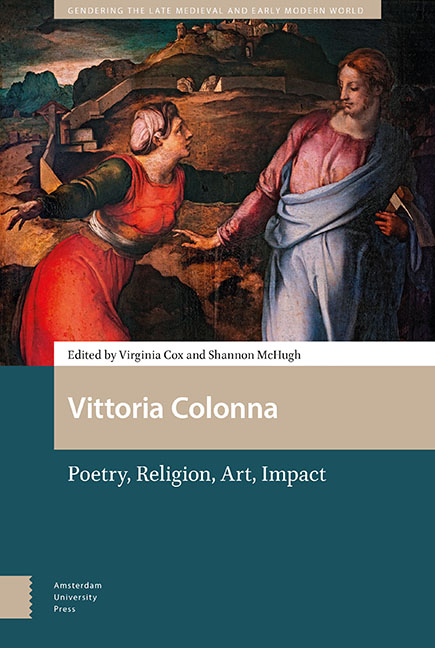Book contents
- Frontmatter
- Dedication
- Contents
- List of Illustrations
- Acknowledgements
- Introduction: The Twenty-First Century Vittoria Colonna
- Part 1 Literary and Spiritual Sociability
- Part 2 Widowhood
- Part 3 Poetry
- Part 4 Art
- Part 5 Readership
- Part 6 Impact
- Volume Bibliography
- Index of Citations of Colonna’s Letters and Verse
- Thematic Index
3 - Magistra apostolorum: The Virgin Mary in Birgitta of Sweden and Vittoria Colonna
Published online by Cambridge University Press: 16 December 2021
- Frontmatter
- Dedication
- Contents
- List of Illustrations
- Acknowledgements
- Introduction: The Twenty-First Century Vittoria Colonna
- Part 1 Literary and Spiritual Sociability
- Part 2 Widowhood
- Part 3 Poetry
- Part 4 Art
- Part 5 Readership
- Part 6 Impact
- Volume Bibliography
- Index of Citations of Colonna’s Letters and Verse
- Thematic Index
Summary
Abstract
Vittoria Colonna used a series of role models, such as the heroines of classical mythology, or female saints such as Catherine of Alexandria and Mary Magdalene, in the construction of her image as an intellectually aspiring and moral exemplary noblewoman. This chapter argues that Birgitta of Sweden (1303–73) should be added to Colonna's gallery of female models. As an aristocratic widow in Rome with reform inclinations, with a strong public voice, and above all with an extensive textual presence that extended throughout Italy and to other European countries, no one could fit better as Colonna's exemplum than Birgitta. As this chapter explores, the clearest traces of Birgittine imitations are to be found in Colonna's radical meditations on the Virgin Mary.
Keywords: The Italian legacy of Birgitta of Sweden, reformed Mariology, Sermo Angelicus, the circulation of Birgitta's revelations in Italian Renaissance, imitation of Mary, Colonna's spiritual poems.
In three letters addressed to her younger cousin Costanza d’Avalos Piccolomini, Vittoria Colonna paints a surprisingly authoritative picture of the Virgin Mary. The letters were collected and published in Venice in 1544 with the title Litere della divina Vetoria Colonna Marchesana di Pescara a la Duchessa de Amalfi sopra la vita contemplativa di santa Caterina e sopra de la activa di santa Madalena. What the title suggests is that the letters focus on two saints who were of special importance for Colonna. Catherine of Alexandria and Mary Magdalene represented two forms of spiritual life, the vita contemplativa and the vita activa, which were widely celebrated in Christian tradition and were the objects of a renewed interest in the Italian Renaissance. Despite not appearing in the title, however, the true protagonist of the volume is the Virgin Mary, who in many ways epitomized the fusion of the contemplative and the active life, an ideal for which Colonna herself so eagerly strove. As we can read in the third letter, while Catherine and Magdalene represent two different approaches to the ‘true sun’ (vero sole) whose rays adorn and embellish them both, the Virgin is chosen over all other women. She is the glorious queen of Paradise and the woman who gave birth to the sun. Therefore, it is Mary, ‘our most singular patron’ (singularissima patrona), as Colonna calls her in the first letter, whom she encourages Costanza d’Avalos to imitate.
- Type
- Chapter
- Information
- Vittoria ColonnaPoetry, Religion, Art, Impact, pp. 75 - 94Publisher: Amsterdam University PressPrint publication year: 2021

